Recent Posts
Restoring Indoor Air Quality After Water Damage: Expert Tips from SERVPRO®
3/12/2025 (Permalink)
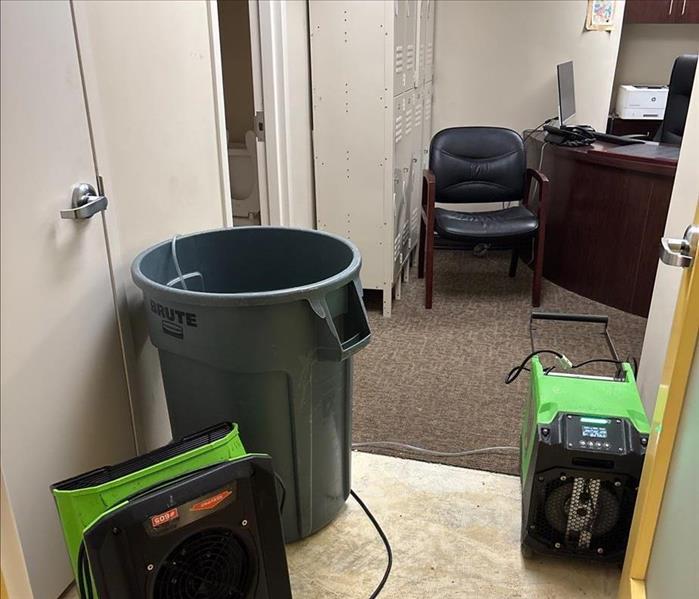 Water damage can impact more than just your floors, walls, and furniture—it can also affect indoor air quality.
Water damage can impact more than just your floors, walls, and furniture—it can also affect indoor air quality.
Water damage can impact more than just your floors, walls, and furniture—it can also affect indoor air quality. Whether caused by flooding, leaks, or burst pipes, excess moisture can create lingering odors and airborne contaminants that reduce the overall air quality in your home or business in Collingdale, PA.
At SERVPRO®, we specialize in comprehensive water damage restoration, including techniques to improve and restore indoor air quality. This guide will walk you through the best practices for restoring indoor air quality after water damage, ensuring a cleaner and fresher environment.
Why Does Water Damage Affect Indoor Air Quality?
When water enters a building, it doesn’t just affect surfaces—it introduces excess moisture into the air. This can lead to:
- Increased humidity levels contribute to lingering dampness.
- Unpleasant odors from water-damaged materials.
- Dust and debris circulate through the air from damaged drywall, insulation, or flooring.
Without proper moisture control and air filtration, these issues can persist long after the water has been removed.
How to Restore Indoor Air Quality After Water Damage
1. Remove Excess Moisture Immediately
The first step in restoring indoor air quality is reducing moisture levels. If water sits for too long, it can lead to musty odors and airborne contaminants.
- Use industrial-grade dehumidifiers to remove excess moisture from the air.
- Run air movers and fans to promote airflow.
- Keep windows and doors open (weather permitting) to allow for natural ventilation.
At SERVPRO, we use professional moisture meters and drying equipment to ensure no hidden moisture is left behind.
2. Improve Ventilation and Air Circulation
Stagnant air can trap moisture and odors, making the space feel damp and musty. Increasing airflow is essential for improving air quality.
- Use HVAC systems to cycle in fresh air.
- Run ceiling fans and box fans to keep air moving.
- Open vents and air registers to prevent damp air from accumulating.
Professional air scrubbing equipment can also help remove airborne particles and refresh the indoor environment.
3. Clean and Replace Air Filters
After water damage, HVAC systems may circulate dust, debris, and moisture-laden air. Cleaning or replacing air filters prevents these contaminants from spreading.
- Replace HVAC and furnace filters with new, high-efficiency filters.
- Clean air ducts if the water damage is extensive.
- Use portable air purifiers to further improve air quality.
SERVPRO offers professional duct cleaning services to remove any water-damaged debris from air ventilation systems.
4. Deep Clean Surfaces and Materials
Even after water is extracted, water-damaged materials can release odors and particles into the air. Cleaning and deodorizing affected areas will help restore indoor air quality.
- Wipe down walls, floors, and ceilings with professional cleaning solutions.
- Shampoo and dry carpets and upholstery to remove trapped moisture.
- Disinfect non-porous materials to eliminate residual odors.
Professional-grade cleaning agents can neutralize odors and refresh indoor spaces more effectively than household cleaners.
5. Use Advanced Air Purification Techniques
For severe cases, professional air purification methods can be used to eliminate lingering airborne contaminants.
Some of the most effective solutions include:
- HEPA Air Scrubbers – Capture fine particles from the air, including dust and debris.
- Ozone Treatments – Neutralize odors in water-damaged properties.
- Hydroxyl Generators – Break down airborne particles safely and effectively.
SERVPRO’s specialized equipment is designed to restore air quality efficiently, ensuring a clean and breathable environment.
FAQs About Restoring Indoor Air Quality After Water Damage
How long does it take to restore indoor air quality after water damage?
Restoring air quality depends on the extent of the damage and drying process. With proper dehumidification and air filtration, air quality can improve within a few days to a week.
Can I use regular household fans to dry out moisture?
While fans help with air circulation, they don’t remove moisture from the air. Industrial-grade air movers and dehumidifiers are much more effective in drying and restoring air quality.
Should I replace my HVAC filter after water damage?
Yes. Water damage can introduce moisture and debris into your air system, so replacing air filters helps prevent further circulation of contaminants.
What if odors persist after drying the water?
Persistent odors may require deodorization treatments, professional air scrubbers, or duct cleaning to fully restore indoor air quality.
SERVPRO: Your Trusted Partner in Water Damage Restoration
Restoring indoor air quality after water damage requires more than just drying out the space—it involves proper ventilation, moisture control, air filtration, and professional cleaning.
At SERVPRO, we use industry-leading air purification techniques to ensure your home or business is fresh, clean, and free of lingering odors.
For expert water damage restoration and indoor air quality solutions, contact SERVPRO today! We’re available 24/7 to help you restore your property.
Differences in fire damage restoration for homes versus commercial properties
12/18/2024 (Permalink)
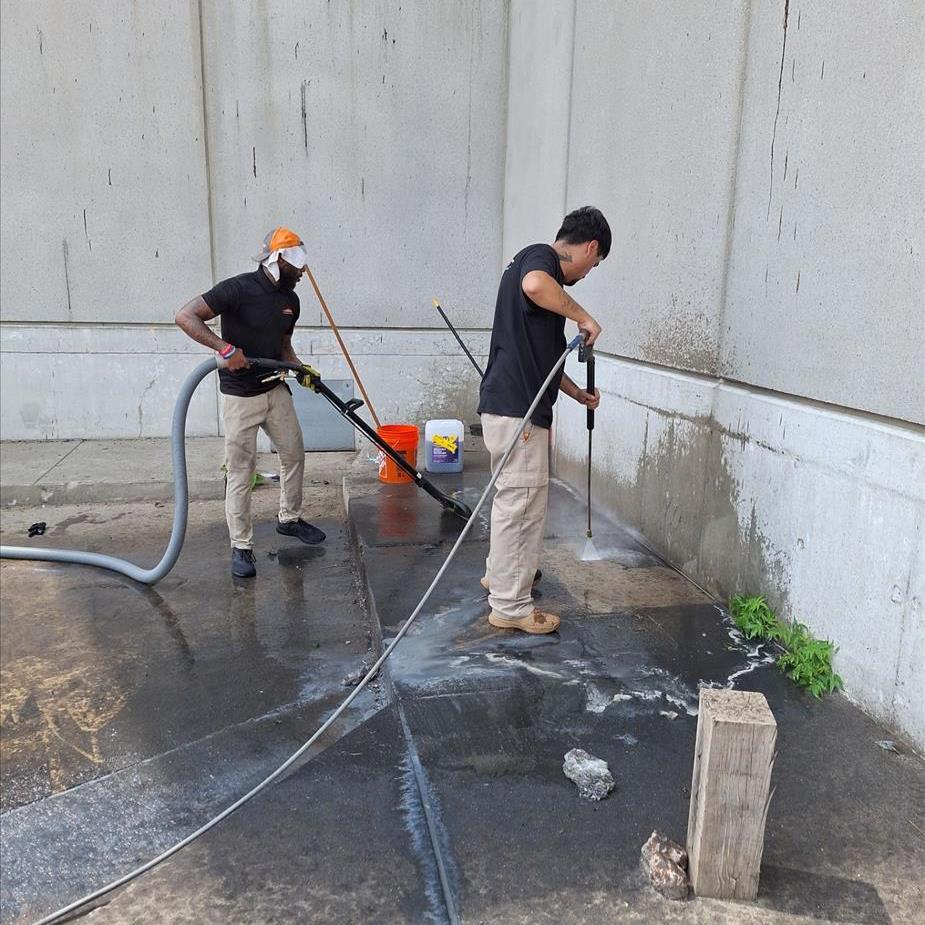 While the core restoration process may seem similar, there are notable differences between restoring fire-damaged homes and commercial properties.
While the core restoration process may seem similar, there are notable differences between restoring fire-damaged homes and commercial properties.
Fire damage restoration requires specialized knowledge, equipment, and experience to address the unique needs of each property type. While the core restoration process may seem similar, there are notable differences between restoring fire-damaged homes and commercial properties. Understanding these distinctions can help property owners better prepare for the challenges of fire recovery.
Scope of Damage
One of the primary differences in fire damage restoration between homes and commercial properties is the scale and scope of the damage. Residential fires tend to affect smaller, confined areas compared to commercial properties, which often have larger footprints and more complex layouts. In a commercial building, fire damage may extend over multiple floors or impact various sections of a large facility, which requires a more comprehensive restoration approach.
Complexity of Systems and Equipment
Restoring fire damage in a commercial setting is often more complex due to the presence of specialized systems and equipment. Commercial buildings typically house intricate HVAC, electrical, and security systems, all of which may be damaged during a fire. Restoration professionals need to assess and repair these systems to ensure the building is safe and functional post-restoration. On the other hand, residential properties typically have simpler systems that are easier to restore.
Business Interruption and Recovery Timeline
For commercial properties, the goal is often to minimize business interruption, which can significantly impact revenue. According to the National Fire Protection Association (NFPA), an estimated 20% of businesses never recover after a fire due to prolonged closures and lost income. To address this, fire damage restoration for commercial properties often includes developing a plan to keep operations running or resume as quickly as possible, whether that involves setting up temporary workspaces or prioritizing key areas for restoration. In contrast, while homeowners are eager to return to their homes, the urgency is typically more focused on personal comfort than business continuity.
Inventory and Documentation
In a home, the fire damage restoration process involves cataloging and restoring personal belongings like furniture, clothing, and heirlooms. For commercial properties, however, restoration professionals must often document and restore expensive equipment, office supplies, and inventory critical to business operations. The scale and value of these items add an extra layer of complexity, as businesses rely on accurate documentation for insurance claims and reimbursement.
Fire Code and Compliance
Commercial properties are subject to stricter fire codes and regulations compared to residential homes. When restoring a commercial building after a fire, SERVPRO® experts must ensure that all repairs and restorations comply with local, state, and federal regulations. This adds an additional level of responsibility and detail to the restoration process.
By understanding the differences in fire damage restoration for homes versus commercial properties, you can see why choosing an experienced restoration company like SERVPRO of South Philadelphia is critical. We have the expertise, equipment, and knowledge to address the unique challenges of each type of property and get you back to normal as quickly as possible.
Mold in Insulation: What to Do When It's Hidden
11/13/2024 (Permalink)
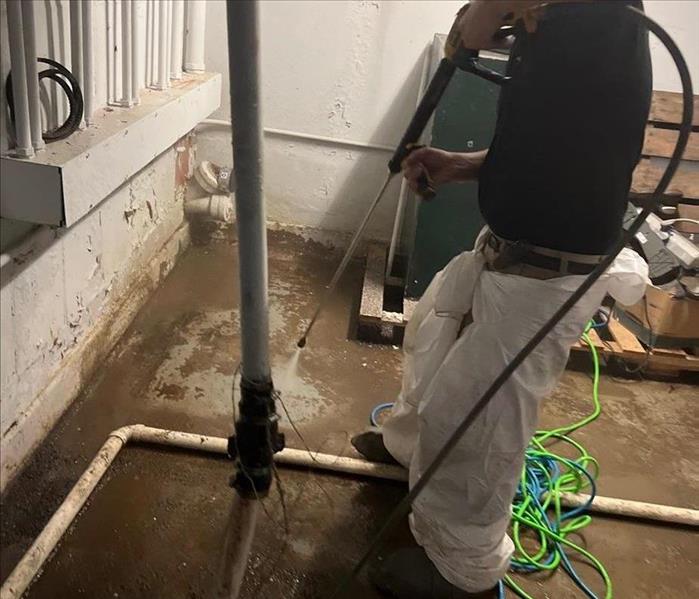 If you suspect mold in your insulation, don’t hesitate to reach out.
If you suspect mold in your insulation, don’t hesitate to reach out.
Mold growth is one of the most common problems homeowners face, and when it forms in insulation, it often goes undetected until the damage is severe. Insulation, especially in areas like attics, crawl spaces, and basements, is particularly susceptible to moisture, creating the perfect environment for mold to thrive. But what should you do when mold is hidden in your insulation, and how can you address it effectively? Here’s a guide to help you tackle this issue.
How Does Mold Get into Insulation?
Mold forms in insulation when moisture seeps in and combines with organic materials like dust or dirt, providing a food source for mold spores. Poor ventilation, roof leaks, and high humidity are common contributors. Fiberglass insulation, while not organic, can still harbor mold if enough moisture is present, especially when it traps dust or debris.
A surprising statistic is that approximately 70% of homes have some form of mold, much of it hidden from view. Insulation often provides the perfect hiding place for this unwelcome guest, making it crucial to take action when it’s discovered.
Signs of Mold in Insulation
Even though mold in insulation can be difficult to spot, there are telltale signs to watch for:
- A persistent musty odor in your home
- Water stains or discoloration on walls or ceilings
- Damp or wet insulation after heavy rains
- Visible mold growth in exposed areas
What to Do When Mold Is Hidden in Insulation
If you suspect mold in your insulation, here are some key steps you should take:
- Inspect the Area: Begin by inspecting areas prone to moisture, such as the attic, basement, or crawl space. Pay attention to any discoloration or musty smells.
- Address the Source of Moisture: Mold won’t grow without moisture, so it’s essential to fix leaks, improve ventilation, or reduce humidity levels.
- Remove and Replace the Affected Insulation: Moldy insulation must be removed carefully to prevent spores from spreading. It’s best to call professionals, as improper removal can worsen the situation.
- Thoroughly Clean the Area: After removing the insulation, clean the surrounding surfaces with appropriate mold removal products to prevent regrowth.
- Install New, Mold-Resistant Insulation: Consider replacing the old insulation with mold-resistant materials, such as foam board or treated fiberglass, to reduce the risk of future mold growth.
Why Call SERVPRO of South Philadelphia?
Mold removal, especially in insulation, requires expert handling. At SERVPRO of South Philadelphia, we have the expertise, equipment, and experience to safely remove and restore mold-infested areas. Whether it’s your attic or basement, we ensure that the mold is gone for good and that your insulation is replaced with the right materials.
If you suspect mold in your insulation, don’t hesitate to reach out. Properly addressing mold growth early can prevent costly damage to your home.
The Essential Role of Proper Insulation in Preventing Water Damage
10/16/2024 (Permalink)
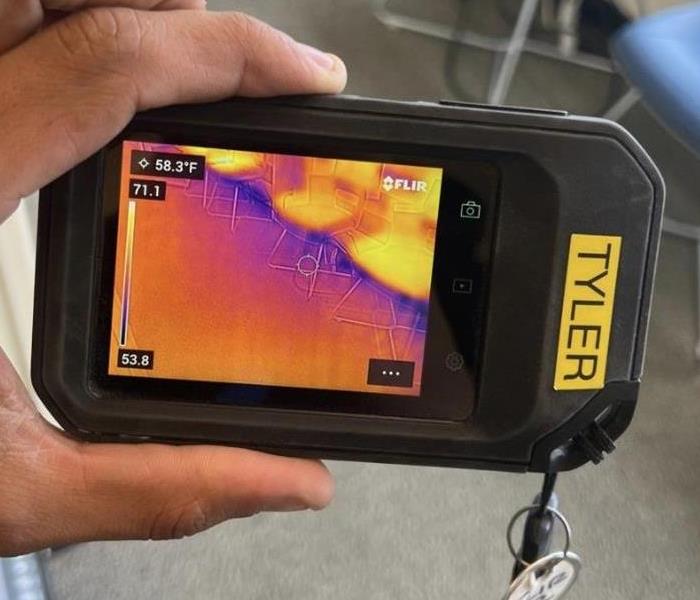 Ensuring your home is well-insulated not only enhances energy efficiency but also plays a crucial role in protecting your property from water damage.
Ensuring your home is well-insulated not only enhances energy efficiency but also plays a crucial role in protecting your property from water damage.
Water damage is one of the most common and costly issues homeowners face in Collingdale, PA. Surprisingly, one of the most effective ways to mitigate this risk is through proper insulation. Ensuring your home is well-insulated not only enhances energy efficiency but also plays a crucial role in protecting your property from the devastating effects of water damage.
How Insulation Helps Prevent Water Damage
Proper insulation acts as a barrier between your home and the elements, helping to regulate temperature and reduce moisture buildup. This is particularly important in areas prone to extreme weather conditions. Insulation helps maintain a consistent indoor temperature, reducing the likelihood of condensation forming on cold surfaces. Condensation, when left unchecked, can lead to water damage over time, particularly in attics, basements, and crawl spaces.
Additionally, insulation serves as a protective layer, preventing water from seeping into the structural components of your home. For example, spray foam insulation can be particularly effective in sealing cracks and gaps in your home’s exterior, thereby preventing water infiltration.
The Financial Impact of Poor Insulation
The financial consequences of inadequate insulation and resulting water damage can be significant. According to the U.S. Environmental Protection Agency (EPA), homeowners can save up to 15 percent on heating and cooling costs by properly insulating their homes. This statistic not only highlights the energy-saving benefits but also underscores the potential cost savings from avoiding water damage. The expense of repairing water-damaged walls, ceilings, and floors can far outweigh the initial investment in proper insulation.
By insulating your home correctly, you’re not just investing in energy efficiency but also safeguarding your property from expensive repairs down the line.
Choosing the Right Insulation for Water Damage Prevention
When it comes to insulation, not all materials are created equal. For optimal water damage prevention, materials like closed-cell spray foam, rigid foam board, and fiberglass batts are recommended. These materials are known for their moisture-resistant properties, making them ideal for areas vulnerable to water intrusion.
It’s also essential to ensure that insulation is installed correctly. Poor installation can lead to gaps and weak spots, undermining the effectiveness of the insulation and increasing the risk of water damage. Hiring a professional to assess your insulation needs and ensure proper installation is a wise investment in the long-term protection of your home.
Conclusion
Proper insulation is more than just a means to save on energy bills; it is a vital component in preventing water damage in your home. By choosing the right insulation materials and ensuring they are installed correctly, you can protect your property from costly water damage repairs. Invest in quality insulation today, and enjoy the peace of mind that comes with knowing your home is well-protected against water damage.
Preventing Ice Dams and Roof Leaks in the Northeast: Essential Tips for Homeowners
9/11/2024 (Permalink)
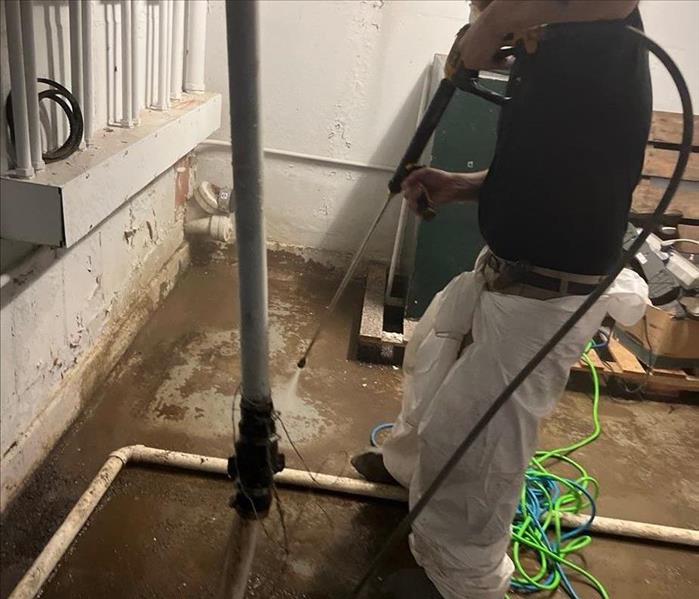 This guide will provide essential tips to prevent ice dams and roof leaks, ensuring your home stays safe and dry throughout the winter season.
This guide will provide essential tips to prevent ice dams and roof leaks, ensuring your home stays safe and dry throughout the winter season.
Winter in the Northeast brings beautiful snowfalls but also the risk of ice dams and roof leaks. Ice dams, ridges of ice forming at the edge of your roof, can cause significant damage to your home. This guide will provide essential tips to prevent ice dams and roof leaks, ensuring your home stays safe and dry throughout the winter season.
Understanding Ice Dams
Ice dams form when the heat from your home melts snow on your roof. The water flows to the colder edges, refreezing and creating a dam. This dam traps additional melting snow, causing water to back up and potentially leak into your home, damaging walls, ceilings, and insulation.
The Impact of Ice Dams in Pennsylvania
In Pennsylvania, ice dams are a common issue due to the state's snowy winters. According to the Insurance Information Institute, ice dams and snow-related roof damage account for a significant percentage of winter weather claims, with Pennsylvania homeowners frequently affected.
Tips to Prevent Ice Dams
1. Improve Insulation and Ventilation
Proper insulation in your attic prevents warm air from escaping, keeping your roof's surface temperature more uniform. Coupled with adequate ventilation, it allows cold air to circulate, minimizing the chances of snow melting and refreezing.
2. Seal Air Leaks
Identify and seal any air leaks in your attic to prevent warm air from escaping and reaching your roof. Use caulk or weatherstripping around pipes, chimneys, and other openings.
3. Install Ice and Water Shield
An ice and water shield is a self-adhesive membrane applied under your roof shingles. It provides an extra layer of protection, preventing water from seeping into your home even if ice dams form.
4. Keep Gutters Clean
Ensure your gutters and downspouts are clear of debris before the snow season. Clean gutters allow melted snow to flow freely, reducing the likelihood of ice dam formation.
Professional Assistance
While these tips can help, professional assessment and maintenance are often necessary for optimal results. SERVPRO® offers comprehensive services to inspect, repair, and winterize your home, preventing ice dams and roof leaks.
Conclusion
Preventing ice dams and roof leaks in the Northeast requires proactive measures and regular maintenance. By improving insulation, sealing air leaks, installing protective barriers, and keeping gutters clean, you can protect your home from winter damage. For expert assistance, contact SERVPRO and ensure your home is ready for the winter season.
By following these guidelines, you can enjoy a worry-free winter, knowing your home is safeguarded against the harsh Northeastern weather.
The Critical Benefits of 24-Hour Emergency Fire Damage Restoration Services
8/14/2024 (Permalink)
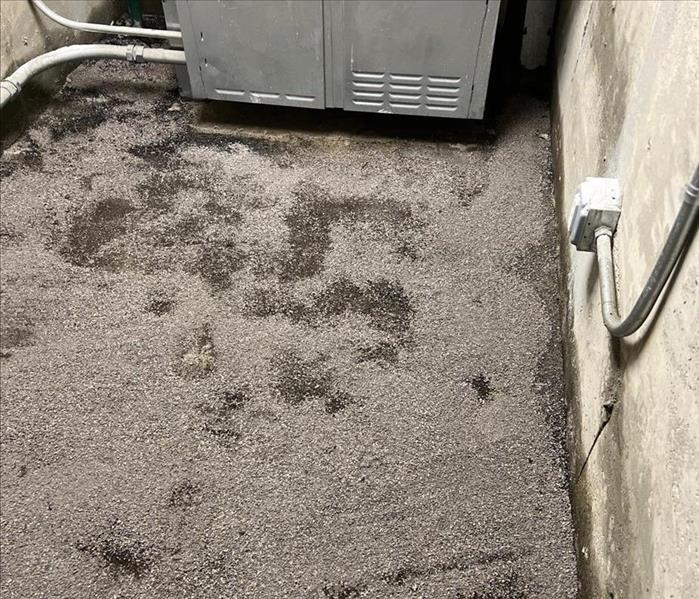 This blog explores the significant benefits of having access to round-the-clock professional assistance.
This blog explores the significant benefits of having access to round-the-clock professional assistance.
Experiencing a fire in your home or business in Philadelphia, PA, is devastating, and the aftermath can be overwhelming. Prompt restoration is crucial to mitigate further damage and begin the recovery process. That's where 24-hour emergency fire damage restoration services come into play. This blog explores the significant benefits of having access to round-the-clock professional assistance.
Immediate Response Minimizes Damage
A swift response is vital after a fire to limit the extent of damage. Fire can cause structural damage, and soot and smoke can continue to harm surfaces and air quality even after the flames are out. A 24-hour emergency service ensures that experts arrive quickly to start the restoration process.
Reduces Health Risks
After a fire, hazardous substances like soot, smoke, and toxic residues linger, posing serious health risks. Professionals equipped with the right safety gear and knowledge can handle these hazards effectively, reducing the risk of respiratory issues and other health problems.
Prevents Secondary Damage
Secondary damage from water used to extinguish the fire can lead to mold growth and structural weakening. 24-hour emergency services can address water damage promptly, using specialized equipment to dry and dehumidify affected areas, preventing mold and mildew.
Comprehensive Assessment and Restoration Plan
A thorough assessment of the damage is necessary to create an effective restoration plan. Emergency fire damage services provide immediate inspections, helping you understand the full scope of the damage and the steps needed for restoration. This comprehensive approach ensures no aspect of the damage is overlooked.
Faster Insurance Claims Processing
Dealing with insurance claims can be stressful. Emergency restoration services often work directly with insurance companies, providing detailed documentation and reports of the damage. This collaboration can expedite the claims process, helping you receive the financial assistance needed for repairs more quickly.
Peace of Mind
Knowing that help is available at any time of the day or night provides peace of mind. Fire emergencies are unpredictable, and having access to 24-hour services means you don’t have to wait for business hours to get the help you need. This immediate support can significantly reduce stress and anxiety during a difficult time.
Why Choose SERVPRO® for Emergency Fire Damage Restoration?
SERVPRO offers reliable 24-hour emergency fire damage restoration services. Our trained professionals are ready to respond quickly, and equipped with advanced tools and expertise to handle any fire damage situation. We prioritize your safety and work diligently to restore your property to its pre-fire condition.
In conclusion, the benefits of 24-hour emergency fire damage restoration services are clear. Immediate response, health risk reduction, prevention of secondary damage, comprehensive assessments, faster insurance claims processing, and peace of mind are all critical during the recovery process. Trust SERVPRO to be there for you whenever disaster strikes.
Proactive Strategies for Mold Prevention During Home Renovations
7/10/2024 (Permalink)
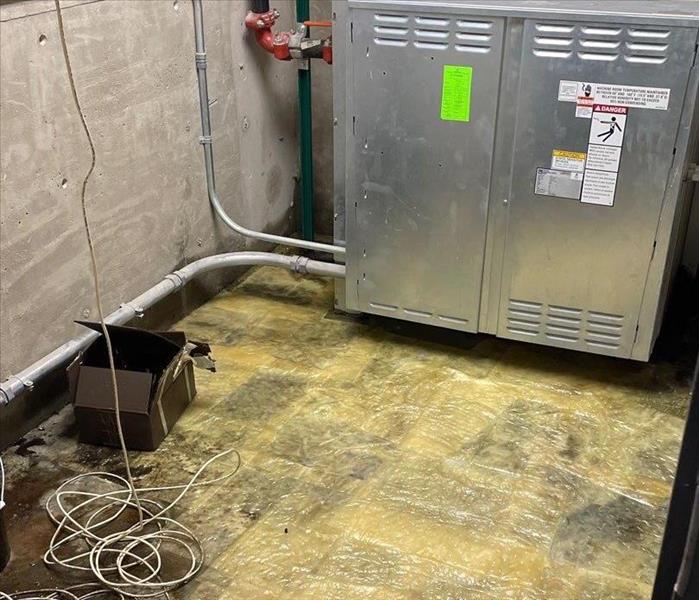 We discuss effective techniques for preventing mold growth during home renovations to ensure a successful and mold-free project.
We discuss effective techniques for preventing mold growth during home renovations to ensure a successful and mold-free project.
Home renovations are an exciting opportunity to enhance the aesthetic appeal and functionality of your living space. However, without proper precautions, renovations can also create conditions conducive to mold growth. Preventing mold during home renovations requires proactive planning and implementation of strategies to minimize moisture buildup and promote a healthy indoor environment. In this blog post, we'll discuss effective techniques for preventing mold growth during home renovations to ensure a successful and mold-free project.
Assessing Potential Mold Risks
Identify Existing Mold
Before starting any renovation project, conduct a thorough inspection of the property to identify any existing mold growth. Look for signs of mold, such as musty odors, water stains, or visible mold growth on surfaces. Addressing existing mold issues before beginning renovations is essential to prevent further spread of mold spores during construction.
Evaluate Moisture Sources
Identify potential sources of moisture that could contribute to mold growth during renovations. Common sources include leaks in plumbing fixtures, inadequate ventilation, and water intrusion from the exterior. Addressing moisture issues upfront can help prevent mold problems down the line.
Implementing Mold Prevention Strategies
Maintain Proper Ventilation
Proper ventilation is crucial for controlling humidity levels and preventing moisture buildup during renovations. Ensure that bathrooms, kitchens, and other high-moisture areas are equipped with exhaust fans or open windows to promote airflow and reduce condensation.
Use Mold-Resistant Materials
Choose mold-resistant building materials whenever possible, especially in areas prone to moisture exposure such as bathrooms and basements. Mold-resistant drywall, paint, and insulation can help minimize the risk of mold growth and ensure long-term durability.
Control Indoor Humidity
Monitor indoor humidity levels throughout the renovation process and take steps to maintain optimal levels between 30% and 50%. Utilize dehumidifiers or air conditioning systems to reduce excess moisture in the air and prevent mold growth.
In the event of water damage or leaks during renovations, address the issue promptly to prevent mold growth. Thoroughly dry affected areas within 24-48 hours and consider hiring a professional restoration company like SERVPRO® to assess and mitigate water damage properly.
Seal Construction Materials
Sealing construction materials, such as wood framing and concrete, can help prevent moisture intrusion and mold growth. Use moisture-resistant sealants and coatings to protect vulnerable surfaces from water damage and ensure long-term durability.
Schedule Regular Inspections
Schedule regular inspections throughout the renovation process to check for signs of moisture buildup or mold growth. Address any issues promptly to prevent further spread of mold spores and ensure a successful renovation project.
Preventing mold during home renovations requires proactive planning and implementation of effective mold prevention strategies. By identifying potential mold risks, maintaining proper ventilation, using mold-resistant materials, and addressing moisture issues promptly, homeowners can ensure a successful and mold-free renovation project. If you encounter mold growth or need assistance with mold prevention during renovations, don't hesitate to contact a professional restoration company like SERVPRO for expert guidance and assistance.
Financial Preparedness for Water Damage Emergencies: Essential Steps to Protect Your Finances
6/17/2024 (Permalink)
Water damage emergencies can happen suddenly and unexpectedly, whether from burst pipes, floods, or leaking appliances. These incidents can cause extensive damage to your home or business and result in costly repairs and restoration. Being financially prepared for water damage emergencies can help you navigate these challenges more easily and reduce the stress of unforeseen expenses. In this blog, we'll discuss essential steps to financially prepare for water damage emergencies and ensure you're ready to handle any situation that may arise.
Review Your Insurance Coverage
Start by reviewing your homeowners or renters insurance policy to understand what is covered in the event of water damage. Look for specific clauses related to water damage, such as coverage for burst pipes, roof leaks, and flooding. If necessary, consider adding flood insurance or a water backup rider to your policy for additional protection.
Understand Your Deductibles
Insurance deductibles are the amount you must pay out-of-pocket before your insurance coverage kicks in. Familiarize yourself with your policy's deductibles for different types of water damage. Setting aside funds for these deductibles can help you avoid financial strain in the event of a water damage emergency.
Establish an Emergency Fund
Having an emergency fund is crucial for handling unexpected expenses, including water damage repairs. Aim to set aside enough money to cover your insurance deductibles and any additional costs not covered by insurance, such as temporary accommodations or upgrades during restoration. This financial safety net can provide peace of mind and financial stability during a crisis.
Create an Inventory of Assets
Documenting your belongings and assets can help you file insurance claims more efficiently and accurately. Take photos or videos of your home's contents and make a list of valuable items. Store this inventory in a safe location, such as a cloud-based service, so you can access it easily in the event of an emergency.
Research Local Restoration Services
Knowing which restoration professionals to contact in the event of water damage can help expedite the restoration process and minimize further damage. Research local restoration companies and keep their contact information readily available. Choose reputable, experienced professionals with positive reviews and credentials to ensure quality service.
Stay Informed About Potential Water Risks
Understanding the potential water risks in your area can help you better prepare for emergencies. For example, if you live in a flood-prone region, familiarize yourself with local flood zones and evacuation routes. If your home has a history of plumbing issues, take preventive measures such as regular inspections and maintenance.
Review and Update Your Plan Regularly
Financial preparedness is an ongoing process that requires regular review and updates. Periodically review your insurance coverage, emergency fund, and inventory to ensure they remain adequate for your current needs. Make adjustments as necessary to stay financially prepared for water damage emergencies.
Being financially prepared for water damage emergencies can help you navigate the challenges of unexpected incidents with greater ease and confidence. Taking these proactive steps can save you time, money, and stress when dealing with water damage emergencies.
Weathering the Storm: The Indispensable Role of SERVPRO in Northeast Storm Damage Restoration
5/13/2024 (Permalink)
The Northeast, characterized by its diverse climate, often experiences the wrath of severe storms that can leave a trail of destruction in their wake. When the tempest subsides, the role of SERVPRO of South Philadelphia / SE Delaware County becomes pivotal in the process of storm damage restoration. Let's explore the essential functions that make SERVPRO® a beacon of hope for Northeastern communities grappling with the aftermath of nature's fury.
Immediate Response and 24/7 Availability
Storms don't adhere to a 9-to-5 schedule, and neither does SERVPRO. With a commitment to immediate response, we operate around the clock, ensuring that their highly trained teams are ready to mobilize at a moment's notice. This swift response is crucial in mitigating further damage and expediting the restoration process.
The first step in storm damage restoration is a thorough assessment. Our professionals meticulously inspect the affected property, identifying the extent of damage and potential safety hazards. Based on this assessment, they develop a tailored restoration plan, addressing the unique challenges posed by each storm.
Water Extraction and Drying
Water intrusion is a common aftermath of storms, and prompt water extraction is paramount to prevent additional issues such as mold growth and structural damage. SERVPRO employs advanced equipment for efficient water removal and thorough drying, ensuring a swift return to a dry and safe environment.
Northeast storms often bring increased humidity, creating an ideal environment for mold to flourish. Our expertise extends to mold remediation, tackling hidden mold colonies and implementing comprehensive cleanup measures to restore indoor air quality.
Structural Restoration
The structural integrity of buildings can be compromised during storms. SERVPRO excels in structural restoration, addressing damages to roofs, walls, and foundations. Their goal is not just to repair but to rebuild, ensuring that the property is restored to its pre-storm condition.
Beyond structural elements, SERVPRO places a strong emphasis on content restoration. From personal belongings to vital documents, their skilled technicians employ advanced techniques to clean, deodorize, and restore items affected by storm damage.
Advanced Technology and Techniques
SERVPRO stays at the forefront of the restoration industry by utilizing cutting-edge technology and innovative techniques. This includes moisture detection tools, thermal imaging, and advanced drying equipment, ensuring a thorough and efficient restoration process.
Navigating insurance claims can be complex, especially after a storm. SERVPRO works closely with insurance companies to streamline the claims process. By providing detailed documentation and facilitating communication, they contribute to a smoother and quicker settlement.
Community Support and Involvement
SERVPRO is more than just a restoration service; they are integral members of the community. Their commitment extends beyond restoration to community involvement and support during times of crisis, fostering a sense of unity and resilience.
Recognizing the importance of proactive measures, SERVPRO engages in educational outreach programs. By imparting knowledge on storm preparedness and preventive measures, they empower Northeastern communities to better protect their homes and businesses.
In the aftermath of Northeast storms, SERVPRO of South Philadelphia / SE Delaware County stands as a testament to resilience and restoration. Their immediate response, specialized expertise, and unwavering commitment to community support make them an indispensable partner in overcoming the challenges posed by severe weather events. From water cleanup to structural restoration, SERVPRO plays a pivotal role in restoring normalcy to the lives of those affected by Northeastern storms.
Why Trust SERVPRO with Your Property Cleaning Needs
4/15/2024 (Permalink)
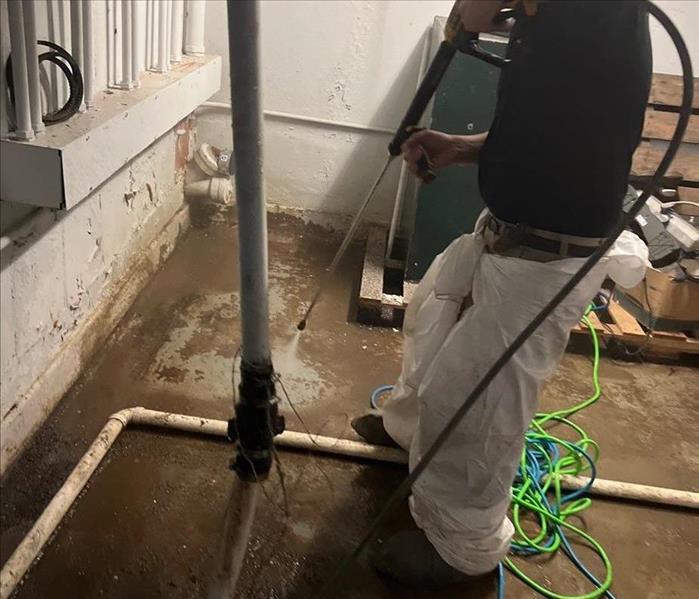 Here are a few ways our team at SERVPRO of South Philadelphia/SE Delaware County can help you clean your property!
Here are a few ways our team at SERVPRO of South Philadelphia/SE Delaware County can help you clean your property!
SERVPRO of South Philadelphia/SE Delaware County is your trusted partner for all your commercial cleaning needs. SERVPRO of South Philadelphia / SE Delaware County has the advanced training and equipment needed to clean and restore your business after any type of damage. We are locally owned, and our highly-trained team of certified professionals is ready to respond - every day, any time. Our goal is to help minimize the interruption to your life and quickly make it "Like it never even happened." Here are a few ways our team at SERVPRO of South Philadelphia/SE Delaware County can help you clean your property:
Trash Chute Cleaning
We’ve recently added trash chute cleaning to our extensive list of services. Here are a few reasons why as a commercial business, you should consider trash chute cleaning:
- Eliminate Odors: Say goodbye to unpleasant smells that can linger in your building. Our professional trash chute cleaning removes built-up grime, bacteria, and odor-causing substances.
- Prevent Pest Infestations: Regular cleaning of trash chutes discourages pests like rodents and insects from making your building their home.
- Enhance Air Quality: Clean trash chutes can significantly improve indoor air quality by reducing the spread of harmful bacteria and allergens. Breathe easy knowing that your building fosters a healthy environment for all occupants.
- Maintain Fire Safety: Dirty trash chutes pose a serious fire hazard. Our expert cleaning technicians ensure thorough removal of flammable materials, reducing the risk of fire and providing peace of mind.
Whether you’re a commercial business with a lot of employees or a commercial apartment building with a lot of residents, our team can be on the job in no time to get your trash chute cleaned up!
Air Duct & Dryer Vent Cleaning
Ventilation systems are often the biggest culprit and poor indoor air quality. Make it a priority to inspect the ductwork of your home or business. If your HVAC has been operating for some time without attention, it could be circulating, one or more of the following:
- Dust
- Pollen
- Odors
- Dirt and debris
- Other contaminants
SERVPRO of South Philadelphia can inspect and determine if duct cleaning is necessary and we will make recommendations about the best way to address any indoor air quality concerns. Our goal is to provide high-quality service to each customer and achieve a cleaner, healthier more energy, efficient, indoor environment.
More Services with SERVPRO®
As a trusted leader in the restoration industry, SERVPRO of South Philadelphia / SE Delaware County can handle partial room losses, large catastrophic commercial/ industrial losses, and regional storm response. We are part of the Philadelphia Region Disaster Recovery Team and have a large and comprehensive inventory of equipment and vehicles and staff to respond quickly and professionally. Here are some of the specifics of what services we have available to our customers:
- Water Removal & Dehumidification
- Fire, Smoke, and Soot
- Mold Remediation
- Sewage Losses
- General Contracting and Rebuilding Services, Demolition
- Document Drying
- Contents Claim Inventory Services
- Deodorization
- Pressure washing (hot and cold water)
- Commercial Carpet & Upholstery Cleaning
- Biohazard, Crime Scene & Vandalism
- Tile & Grout Cleaning
- Ceilings, Walls & Hard Floors (stripping & waxing)
If you need any of the services and are located in the Philadelphia/Delaware County area, contact our team at SERVPRO of South Philadelphia / SE Delaware County at (215) 243-0430 or (610) 237-9700. We’re available 24/7/365 to help you after property damage!
 Water damage can impact more than just your floors, walls, and furniture—it can also affect indoor air quality.
Water damage can impact more than just your floors, walls, and furniture—it can also affect indoor air quality.






 24/7 Emergency Service
24/7 Emergency Service






